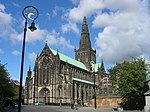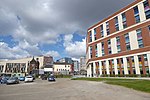Glasgow Lock Hospital
Defunct hospitals in ScotlandHealth in GlasgowHospitals established in 1805Hospitals in GlasgowSexual health ... and 1 more
Women's health in the United Kingdom

The Lock Hospital for Women was a hospital in Glasgow for women suffering from venereal disease.
Excerpt from the Wikipedia article Glasgow Lock Hospital (License: CC BY-SA 3.0, Authors, Images).Glasgow Lock Hospital
John Street, Glasgow Merchant City
Geographical coordinates (GPS) Address Nearby Places Show on map
Geographical coordinates (GPS)
| Latitude | Longitude |
|---|---|
| N 55.861715 ° | E -4.238422 ° |
Address
University of Strathclyde
John Street
G1 1HP Glasgow, Merchant City
Scotland, United Kingdom
Open on Google Maps









